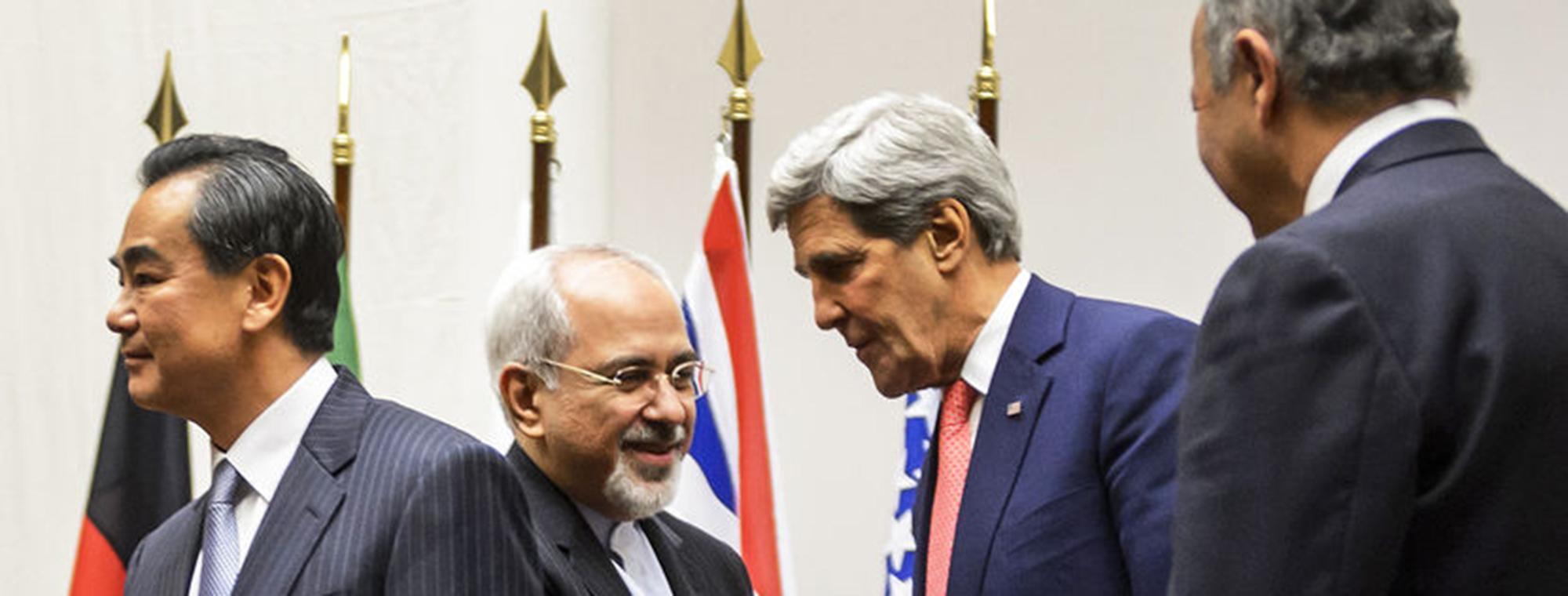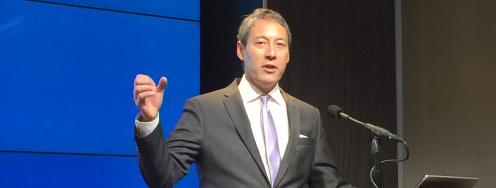Editor's Note: This essay is featured in our new report, "10 Big Nuclear Ideas for the Next President" (pdf).
Since official relations between Washington and Tehran were severed in 1980, five American presidents spanning a period of three decades — from Jimmy Carter to George W. Bush — have struggled to figure out how to deal with Iran. As a candidate for the presidency in 2007, then-Senator Barack Obama indicated that if elected he would take a different approach from his predecessors and “engage in aggressive personal diplomacy” with Iran. “For us not to be in a conversation with them doesn’t make sense,” he said.
Once in office, President Barack Obama pursued a dual track policy toward Iran. He began by putting in motion a “pressure track” aimed at weakening and isolating Iran’s economy through international sanctions that were harsher than those of the previous administration. In 2012, he initiated an “engagement track” and authorized US officials to participate in secret diplomatic exchanges with their Iranian counterparts. This underthe-radar dialogue paved the way to formal negotiations within the context of the “P5+1” group of major powers that included the five permanent members of the United Nations Security Council — China, France, Russia, the United Kingdom and the United States, plus Germany.
The result of this three-year process of diplomacy is the landmark nuclear accord known as the Joint Comprehensive Plan of Action (JCPOA) reached in July 2015. The JCPOA places strict limits on Iran’s nuclear program — including a sharp reduction in Iran’s uranium enrichment capacity that increases breakout time from around 90 days to a year, the full elimination of the plutonium path to a nuclear weapon, and the establishment of a rigorous monitoring and inspections system — in exchange for sanctions relief.
The administration’s limited outreach to North Korea stands in sharp contrast. As part of the February 2012 Leap Day deal, the US negotiated a moratorium on the DPRK’s nuclear and missile testing in exchange for targeted food assistance. But a satellite launch by Pyongyang led to the agreement’s collapse in April 2012 and diplomacy fizzled. Some thought the visit of US Director of National Intelligence James Clapper to Pyongyang to secure the release of two Americans in November 2014 would lead to diplomatic traction. Although Director Clapper returned home with the US citizens in his custody, the diplomatic overture went nowhere. In fact, there has been no meaningful official dialogue between Washington and Pyongyang since Kim Jong-un assumed power following the death of his father Kim Jong-il in 2011.
Under the younger Kim’s leadership, Pyongyang has sharply accelerated efforts to advance its nuclear and ballistic missiles program. North Korea carried out its fifth nuclear weapons test in September 2016 and has launched an ongoing series of missile, rocket and other weapon tests throughout the year in violation of UN Security Council resolutions. Although some of these missile tests have been deemed “failures” by experts, it would be a mistake to discount them as the North Koreans have demonstrated learning along the way. In June, Pyongyang successfully test-launched a ballistic missile that put US military bases in South Korea, Japan and Guam within reach. A submarine-launched missile in August is estimated to have reached its longest distance to date (about 310 miles).
Some project that North Korea’s nuclear arsenal could increase from an estimated one to two dozen weapons today to as many as 100 weapons by 2020. Experts see the North Korean leadership’s twin end goals to be the ability to successfully mount nuclear warheads on ballistic missiles and to develop nuclear weapon delivery systems capable of striking the continental United States. In response to these provocations as well as ongoing human rights abuses, the Obama administration has steadily increased sanctions on Pyongyang, including tougher UN sanctions in March and unprecedented unilateral sanctions specifically targeting Kim Jong-un and senior officials in his government in July.
As the Obama presidency draws to a close, the intensifying stalemate over Pyongyang’s advancing nuclear and missile programs will be passed along to the next president to deal with. Whether a new US administration would be willing to expend the political capital needed to begin diplomatic engagement with North Korea early on is a big question. But given North Korea’s expanding nuclear activities — both in terms of intentions and actual progress — along with its growing ability to work around sanctions, the next administration would be welladvised to take a page from President Obama’s playbook with Tehran and explore “aggressive diplomacy” with Pyongyang as a priority.
It is tempting to want to think that the Iran deal could be a blueprint for North Korea. But the two cases are so different that it’s difficult to compare them. North Korea has crossed the nuclear weapons threshold, while Iran has never possessed a nuclear weapon. Iran is a party to the Nuclear Nonproliferation Treaty (NPT) and North Korea isn’t. Beyond this, differences abound in the two countries’ systems of government, economies, demographics, and so forth. As an American who has had the rare opportunity to travel to both countries over the years, I have experienced these differences firsthand.
It is clear that the applicability of the JCPOA as a model is limited at best. Nonetheless, the process of diplomacy that the US pursued with Iran could offer some insights on how to begin engagement with an adversary whose leadership is extremely distrustful of the United States, and vice versa.
The following draws on the experience with Iran and identifies some key takeaways for beginning engagement with North Korea.
Initiate a Low-Key Diplomatic Channel, Authorized at the Highest Level
The Obama administration’s outreach to Iran’s leadership represented a bold stroke of diplomacy.It was a decision made by the president to establish a backchannel to resolve the longrunning standoff over Iran’s nuclear program. Following several years spent on the methodical build-up of an international sanctions coalition against Iran, American officials began discreet discussions with their Iranian counterparts in July 2012 in Muscat, with the Omanis serving as a third-party facilitator. The change in players on the Iranian side from the Mahmoud Ahmadinejad administration to the Hassan Rouhani administration in June 2013 helped to move the process forward.
Through these discussions, the Americans conveyed a turn away from “regime change” in Iran as a strategic objective. While making clear that the US was not prepared to accept a nuclear weapons capable Iran under any circumstances, they communicated they were prepared to accept Iran having a peaceful, heavily monitored nuclear capability, signaling some enrichment activities could be continued. They also dropped the precondition of requiring Iran to suspend enrichment in order to begin direct talks on the nuclear issue. These assurances and clarifications made it possible for the Iranians to move forward. As a result of the dialogue and an exchange of letters between Presidents Rouhani and Obama, US officials came away with the belief that Iran was ready to begin negotiations that could lead to limiting their nuclear activities to peaceful purposes.
There reportedly were a total of 12 such secret meetings convened in Muscat, Geneva and New York over a period of about 16 months, leading to an interim agreement called the Joint Plan of Action (JPOA) in November 2013.
Key takeaways for North Korea: The Iranian leadership took the outreach seriously because they knew the decision to engage was made at the highest level in Washington. The Iranian negotiators, in turn, were authorized to take part in the discussions by Iran’s Supreme Leader Ali Khamenei. The direct bilateral channel made it possible for the sensitive talks to be conducted away from the limelight and over a period of time that allowed the negotiators to have substantive, detailed discussions. (The breakthrough in US-Cuban relations began in a similar way when President Obama authorized secret talks in spring 2013 with Cuba.) The dialogue provided opportunities for American and Iranian officials to convey authoritative messages and reassurances, opening the way for an interim deal.
The centrality of the role of US diplomacy made the agreement possible. Although the interim agreement was nominally a deal between Iran and the P5+1 states, it was in fact the direct talks between Iran and the United States that led to the final agreement. Similar dynamics appear to be at work in Northeast Asia, where all of the regional powers acknowledge that there must be direct discussions and an agreement between the DPRK and the US for any progress to be made.
Focus on a Limited Set of Realistic Objectives, Not a “Grand Bargain”
The history of US-Iran relations since 1979 is strewn with failed attempts at engagement. While keeping in mind these failures — along with the considerable domestic political constraints they were sure to face — American and Iranian officials concluded they would have a greater chance of success by limiting the focus of their discussions to Iran’s nuclear program and sanctions relief. They adopted a “win-win” narrative early on as a way of acknowledging that concessions by both sides would have to be made in order to get to a successful outcome.
The many profound differences that exist between the two governments were not part of the dialogue — nor were the objectives of a broader rapprochement and diplomatic normalization. They set an initial goal of hammering out an interim agreement, which froze key elements of Iran’s nuclear program in exchange for limited sanctions relief and provided the time and political space for the P5+1 to pursue a more comprehensive final accord. As part of this incremental process, consensus on a framework was reached in April 2015, providing a path to a final agreement in July 2015.
Key takeaways for North Korea: The interim agreement was already in place for a two-year period by the time implementation of the JCPOA began in January 2016. Iran’s full compliance with the interim agreement — which was verified consistently by the International Atomic Energy Agency (IAEA) during this period — provided a way to test Iran and served as a much-needed trust-building function for both sides. This was important because Iran, like North Korea, had violated international nonproliferation norms in the past.
The discussions were limited to what both sides deemed to be a very specific and manageable set of agenda items in the nuclear field (this focus enabled the US to maintain its full set of sanctions related to terrorism and human rights against Iran). Unlike the 1994 Agreed Framework that sought to end North Korea’s nuclear weapons program and ultimately failed, the negotiations and the resulting agreement with Iran did not call for a normalization of relations. In the end, both sides’ commitment to a “win-win” outcome enabled them each to say they succeeded in fulfilling their objectives. The multilateral context of the P5+1 provided the framework that made a final agreement possible.
A Priority for the Next Administration
When a new administration takes office in January 2017, a review of US policy toward North Korea should be placed high on its to-do list. Such a review should yield a definitive conclusion that the current policy of “strategic patience” — continuing to apply pressure through sanctions and waiting to see if North Korea will change its current course and denuclearize or collapse — is not working. The right next step would be to try another approach with the aim of bringing North Korea back to the negotiating table and reviving the Six-Party talks or a new set of regional security talks. Key elements of this approach must include pressing Beijing to play a more constructive role, while strengthening policy coordination with Seoul, Tokyo and other partners.
Perhaps the most obvious and biggest lesson to be gleaned from the Iran nuclear deal for North Korea is that principled and pragmatic diplomacy in the absence of trust is hard, but it’s not impossible. The four-year plus period that began with the backchannel negotiations in July 2012 to today represents the most intensive run of continuous, official dialogue between Tehran and Washington since relations were cut in 1980. US Secretary of State John Kerry is on track to end his tenure as having had more face-to-face meetings with Iran’s Foreign Minister Javad Zarif than with any other foreign minister. Such interactions, which were once unthinkable, have now become normal.
Of course, the case of North Korea presents a unique set of circumstances and challenges. But, as I have outlined above, there are some guiding principles that could be extracted from the experience with Iran. Without full buy-in at the highest level of leadership, any effort to engage is likely to lead to a dead-end. Given the outsized sensitivities and deep mistrust in these cases, a low-key and steady channel for dialogue would provide the best way forward. Sticking to a very specific set of mutually-agreed upon agenda items and manageable objectives and working within a broader multilateral framework would increase the chance of reaching acceptable and sustainable outcomes.
Pyongyang’s track record of deception, provocation and violation of past agreements and UN resolutions is not reassuring. But the absence of dialogue puts us in a real disadvantage as we have very little direct knowledge about North Korea. Even if dialogue doesn’t lead to a breakthrough as it did with Tehran, engagement could provide opportunities to assess the North Korean leadership’s strategic priorities, capabilities, intentions and threat perceptions — and lead to more informed judgments and better options for US policy beyond waiting and seeing.
Suzanne DiMaggio is a senior fellow at New America, where she directs a long-running US-Iran policy dialogue and a recently launched US-North Korea Track 2 Dialogue. A version of this essay was published in Foreign Policy on September 12, 2016.
Photo: Iranian Foreign Minister Mohammad Javad Zarif shakes hands with US Secretary of State John Kerry, Nov. 24, 2013. Fabrice Coffrini/AFP/Getty Images
Learn from Iran, Engage North Korea @suzannedimaggio @NewAmerica.




